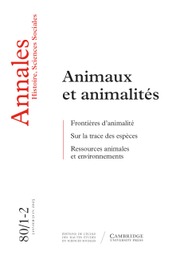Article contents
Fluctuations climatiques : une étude synoptique du climat, fin XVIIIe-début XIXe siècle
Published online by Cambridge University Press: 25 May 2018
Extract
L'étude des fluctuations climatiques pendant les temps historiques est fonction de la découverte et de la confrontation de sources adéquates et fiables. E. Le Roy Ladurie, utilisant des données quantitatives soit directement, soit après traitement, a dessiné un synopsis magistral de l'histoire du climat au cours du dernier millénaire. On a enregistré, quoique de façon irrégulière au début, des observations instrumentales à travers une bonne partie de l'Europe pendant le dernier tiers de ce millénaire. Le regroupement et le recoupement minutieux d'un tel matériel ont permis de reconstituer des séries de longue durée pour plusieurs régions d'Europe ; ainsi pour l'Angleterre centrale à partir de 1659 et pour l'Europe centrale à partir de 1761.
Summary
The present article reviews a research project concerning the construction and analysis of historical daily synoptic weather maps from 1781. The 1780's were selected as a starting point both because adequate sources of data existed from that time on and because climatic conditions during this period were distinctly different from those of 1900-1939.
After a brief discussion of the development of instrumental meteorological observing over the past three centuries, a comparative investigation is undertaken between the 40-year climatic period 1781-1820 and the “normal” datum 1900-1939. The Lamb British Isles weather types and circulation patterns are applied to selected 4-year phases. The data are presented in tables of yearly and average frequencies of weather types and tables of the central England temperature series.
Further synoptic climatological studies are suggested, including investigation of large-scale circulation patterns and construction of 500 millibar charts.
- Type
- Le Climat Dans L'Histoire
- Information
- Copyright
- Copyright © Les Éditions de l’EHESS 1977
References
Notes
1. Le Roy Ladurie, E., Times of feast, times of famine : A history of climate since the year 1000, Londres, Allen & Unwin, 1972 Google Scholar.
2. Manley, G., « Central England temperatures : monthly means 1659 to 1973 », dans Quart. J.R. Met. Soc., Londres, 1974, p. 389 CrossRefGoogle Scholar.
3. Baur, F., « Langjàhrige Beobachtungsreihen », dans Linke, Meteorologisches Taschenbuch, Leipzig, 1962, p. 710 Google Scholar.
4. R. G. Barry et A. H. Perry, Synoptic climatology, methods and applications, Londres, Methuen, 1973.
5. J.-P. Desaive, J.-P. Gouberf, E. Le Roy Ladurie, J. Meyer, O. Muller, J.-P. Peter, Médecins, climat et épidémies à la fin du XVIIIe siècle, Paris-La Haye, Mouton, 1972.
6. Kington, J. A., « A late eighteenth century source of meteorological data », dans Weather, Londres, 1970, p. 169 CrossRefGoogle Scholar.
7. Kington, J. A., « The Societas Meteorological Palatina : an eighteenth-century meteorological society », dans Weather, Londres, 1974, p. 416 CrossRefGoogle Scholar.
8. Kington, J. A., «Meteorological observing in Scandinavia and Iceland during the eighteenth century», dans Weather, Londres, 1972, p. 222 CrossRefGoogle Scholar.
9. Olivier, J. et Kington, J. A., « The usefulness of ships’ log-books in the synoptic analysis of past climates », dans Weather, Londres, 1970, p. 520 CrossRefGoogle Scholar.
10. Kington, J. A., « A comparison of British Isles weather type frequencies in the climatic record from 1781 to 1971 », dans Weather, Londres, 1975, p. 21 CrossRefGoogle Scholar.
11. H. H. Lamb, British Isles weather types and a register ofthe daily sequence of circulation patterns, 1861-1971, Geophysical Memoirs, XVI, n° 116, Londres (HMSO), 1972.
12. Murray, R. et Lewis, R. P. W., «Some aspects of the synoptic climatology of the British Isles as measured by simple indices», dans Meteorological Magazine, Londres, 1966, p. 193 Google Scholar.
13. Kington, J. A., «An analysis of the seasonal characteristics of 1781-1784 and 1968-1971 using the PSCM indices», dans Weather, Londres, 1975, p. 109 CrossRefGoogle Scholar.
14. H. H. Lamb et A. I. Johnson, Secular variations ofthe atmospheric circulation since 1750, Geophysical Memoirs, XIV, n° 110, Londres (HMSO), 1966.
15. Davis, N. E., « Classified central-England temperatures and England and Wales rainfall », dans Meteorological Magazine, Londres, 1972, p. 205 Google Scholar.
16. Kington, J. A., « An introduction to an examination of monthly and seasonal extremes in the climatic record of England and Wales using historical daily synoptic weather maps from 1781 onward », dans Weather, Londres, 1976, p. 72 CrossRefGoogle Scholar.
17. Kington, J. A., «The construction of 500-millibar charts for the eastern North Atlantic-European sector from 1781», dans Meteorological Magazine, Londres, 1975, p. 336 Google Scholar.
18. Baur, F., « Extended-range weather forecasting », dans Compendium of meteorology, Boston (American Meteorological Society), 1951, p. 814 CrossRefGoogle Scholar.
19. Dzerdzeevskii, B. L., « Fluctuations of generai circulation of the atmosphere and climate in the twentieth century », dans Changes of Climate, Paris, Unesco, 1963, p. 285 Google Scholar.
20. Murray, R., « On predicting seasonal weather for England and wales from anomalous atmospheric circulation over the Northern hemisphere », dans Weather, Londres, 1972, p. 396 CrossRefGoogle Scholar.
21. Ratcliffe, R. A. S., «The use of 500-mb anomalies in long-range forecasting», dans Quart. J. R. Met. Soc, Londres, 1974, p. 234 CrossRefGoogle Scholar.
- 1
- Cited by


